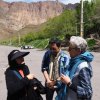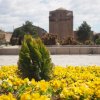Skyring
Established Member
- Joined
- Oct 18, 2005
- Posts
- 2,216
- Qantas
- LT Silver
There's an Armenian church in the centre of Tehran. They are allowed to distill their own alcohol. Christians and a few other faiths are accepted. Not likely to gain much in the way of good jobs, though.Despite the mihrab-like main doorway, it is evident from the various crosses that this is a Christian edifice. I don't suppose any monks were in residence, though. Did you get any impression of the extent to which Christianity is tolerated in Iran, or is it just that a few historic structures are retained for their tourist-attracting potential?
The monastery is no longer used as such, but it remains a Christian church. There were candles burning. Very low key, though.
Islam is certainly the dominant faith, but not to the extent that (say) Christianity is in Texas. Mosques are generally small and poorly patronised. I think most people go only on special occasions and it is just the fully committed who attend or do the five prayers. These are amalgamated into three for convenience and I couldn't find anyone who admitted doing them. As a taxi driver in Australia I saw more people praying here than I did in Iran. I get the feeling that it is the older generation who observe, and the younger ones pay lip service.
Islam in Iran has been the official religion for so long, but most people found more interesting things to do on a Friday than listen to some mullah preach. Persians weren't exactly rigid observers before the revolution, and Khomeini was welcomed more as a non-Shah leader than a religious hero.
In theory, the religious hierarchs control the government. In practise, their grip is steadily weakening. In a few places, like Qom, they are full tilt Muslim. In the rest of Iran, not so much.































































